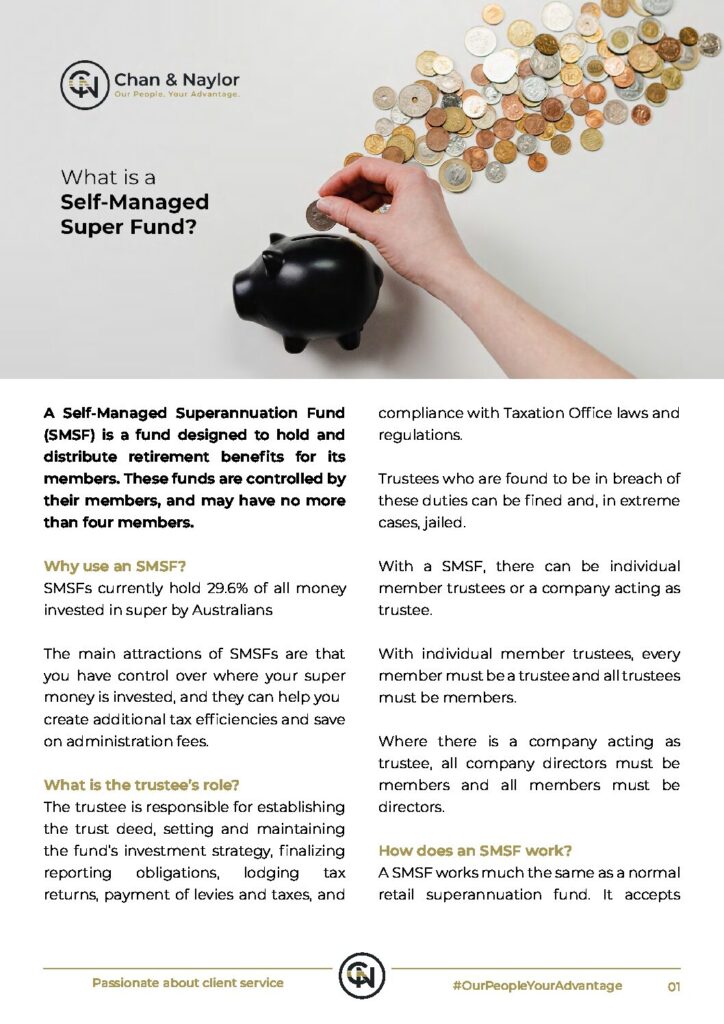Self-Managed Super Funds (SMSF)
What is a SMSF (Self Managed Superannuation Fund)
An SMSF is a superannuation fund that is managed by you. An SMSF allows you to take control over the investment strategy of the fund. It also provides greater flexibility in terms of investing the funds’ assets, retirement income options and estate planning; but it is important to understand the responsibilities that come with being a SMSF trustee.
Australian Tax Office figures reveal that as of 30 June 2019, there were 599,678 SMSFs in Australia holding nearly $748 billion in assets, making total assets held in SMSFs larger than those in either industry ($719 billion) or retail ($626 billion) funds.
Perhaps the main reasons why more Australians are embracing SMSFs is that it allows you:
Control – Decide what you want to invest in and decide when your benefits are paid – in other words, SMSFs allow you to control your wealth creation strategy in super.
Gearing – Use borrowed money in super to invest in assets such as property. Investing in property has the potential to significantly improve wealth creation and the overall fund balance by the time you transition to retirement – in other words, gives you the ability to leverage for improved wealth creation in super.
Consolidate – Aggregate and invest a family’s superannuation benefits as well as provide a pool of monies and assets to look after family members, including children and grandchildren at the time of an accident, sickness, permanent disability, death, pre-retirement and retirement – in other words, gives you greater flexibility to create long term wealth for your family – not just your retirement.
SMSF – Setting up your own | Things to Consider
Running your own SMSF can provide a great means of managing your retirement savings, with the potential for more control, greater choice, and lower costs. In fact, more than one million Australians are now members of a SMSF.
Each member of a SMSF is required to be a trustee of the fund (either as an individual or as a director of a corporate trustee). As a SMSF trustee, you take on the responsibility for the fund’s performance and have certain obligations to comply with self-managed super fund rules.
Managing your own retirement funds can be very rewarding, but here are some of the key responsibilities that you need to be aware of:
1. Make sure a self-managed super fund is right for you
Your responsibilities begin before you even start. With the increasing popularity of SMSFs, it is tempting to rush in and set one up, however running an SMSF is not for everyone.
Do your research and consider seeking professional advice before making the decision to set up an SMSF. By deciding to set up an SMSF, you are choosing to take personal responsibility for both the selection and the management of the fund’s investments and the legal compliance of the fund. Running an SMSF demands time, commitment, knowledge, and professional support. We offer a financial planning service to help decide if it is in your best interests.
2. Understand your SMSF’s framework
- Your fund’s structure – the specific requirements for your fund will differ depending on how it is set up, in particular whether it has a single member, individual trustees or a corporate trustee.
- Your fund’s trust deed – “A trust is an arrangement where a person or company (the trustee) holds assets (trust property) in trust for the benefit of others (the beneficiaries). A super fund is a special type of trust, set up and maintained for the sole purpose of providing retirement benefits to its members (the beneficiaries).”
Your fund’s trust deed will need to be prepared by a qualified professional as it is a legal document. As well as being the instrument that establishes the fund, your deed sets out factors such as the structure of the fund, your investment strategy, who can be beneficiaries and how benefits can be paid. These are important decisions that determine the direction of the fund.
3. Comply with SMSF regulations
Being the trustee of a SMSF demands a commitment to understanding and keeping up with the rules and regulations surrounding SMSFs. We will continue to educate you around the do’s and don’ts. You (and any other trustees) need to make sure the fund is compliant with numerous regulations.
4. Compliance obligations for SMSFs include:
- Each year you need to prepare and lodge your fund’s annual return with the ATO. This involves preparing financial accounts and statements that meet the accounting standards reporting member contributions and paying the SMSF supervisory levy.
- You must keep comprehensive records, including accurate tax and accounting records, minutes regarding all trustee meetings and decisions (regarding investments or any other matters affecting the fund), trustee declarations recognising their obligations and responsibilities, and copies of all reports given to members.
- You need to arrange an annual audit by an approved SMSF auditor (we can assist here).
It is our role as your advisor to help you as a SMSF trustees attend to all of this, plus so much more.
5. Make sure you are in it for the right reasons
Your fund has to be created and maintained for the sole purpose of providing retirement benefits to the members (or their dependents if a member dies before retirement). The sole purpose test is a cornerstone of SMSF law and is designed to protect your retirement savings. If your fund does not operate for this sole purpose it will not be eligible for the attractive tax concessions which are normally available to a compliant SMSF. Even more seriously though, trustees may face civil and criminal penalties.
It is your responsibility as a trustee to ensure your fund does not contravene the sole purpose test.
6. Invest wisely
While managing your own superannuation fund does give you flexibility and control when it comes to investing your fund’s money, you must always invest according to the fund’s trust deed, investment strategy and superannuation law.
The trustees of the fund make all the investment decisions for the fund; you are responsible to develop, implement and regularly review your investment strategy and portfolio. This means understanding your investment options and legal obligations, which requires making time to research and manage your investments.
Some important considerations for an SMSF trustee are:
- Do you have enough time to manage an SMSF?
- What are your reporting obligations as a trustee?
- Will someone help you set up and run your SMSF?
- How do you keep up to date with changes to superannuation laws and legislation?
- What is the sole purpose test?
- What is an investment strategy?
- Are you eligible to become a trustee?
Summary
As the fastest growing and largest sector of the superannuation industry, SMSFs are proven to have widespread appeal. More and more Australians turn to SMSFs every day to hold their retirement savings; drawn by the opportunity to control their own funds, access a wider range of investment choices and potentially pay lower fees.
Remember, each trustee is responsible for the fund (and cannot be paid for performing the role). As a SMSF trustee, it is your duty to protect the assets of the SMSF and to ensure that the fund meets the needs of the members and remains compliant with relevant rules and regulations. Providing that you understand and uphold your responsibilities as a trustee of your fund, managing your own superannuation can be very rewarding. Therefore, it’s prudent to get expert financial advice, professional guidance and support from trusted advisers that specialise in superannuation strategies, superannuation management and administrative compliance.

